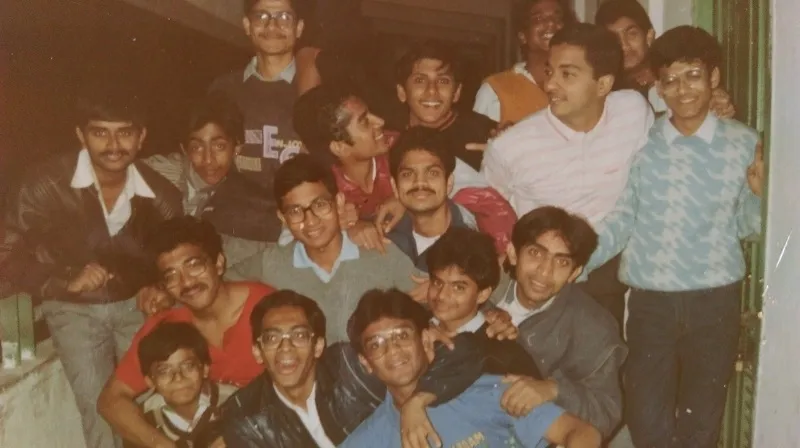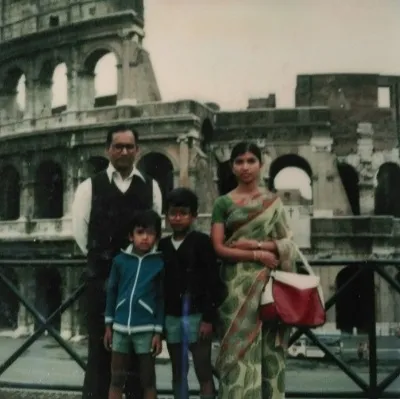[Techie Tuesdays] Shamik Sharma, the PhD dropout computer scientist who controls the technology and product at Myntra
If you’re here to read about a crazy techie who hacked his way into the most intricate and secure information systems on the Internet, then I would strictly recommend you to go no further. This week’s Techie Tuesdays might not give you an adrenaline rush, but it will help you better understand technology.
Shamik Sharma is a man of calculated words, visibly carrying two decades of experience and wisdom with him.
While we were waiting in a meeting room at the Myntra office, Shamik entered the room dressed in a chequered bush shirt for the interview. He was calm, composed and looked liked a professor about to take class. At the same time, two things were very clear: It’s going to be hard to indulge in candid conversations, and there is no way this interview is going to last long.
Yet, we persevered.
This week we explore the Shamik Sharma that's more than a computer scientist heading Product and Technology at Myntra.

Where do I belong to?
Shamik was born in Chikkadpally in Hyderabad to the famous botanist and agricultural scientist, Dr. Shatanjiw Das Sharma. He was a part of the green revolution which took part in 1960s and 70s when the rice production went up by manifolds in South East Asia. Pursuing his research and work, Dr. Shatanjiw went to Nigeria, followed by Shimla and Orissa and so Shamik had his schooling at different geographies. Eventually, it was not clear to him where did he belong to. In 1987, he debated strongly while choosing between IIT-Madras, Bombay or Kharagpur for the same reason. He still doesn’t have an answer to this question.
Graduation – check. Post graduation-check. PhD- ??
After graduating from IIT-Kgp in Computer Science, Shamik was expected to follow his father's footsteps and go for a PhD to become an academic. He says,
I was along that path when suddenly everybody was leaving to go to the bay area and I was in Washington DC in University of Maryland pursuing my PhD after completing my masters. I wanted to be close to the bay area where everything was happening at that time.

He decided to drop out of his PhD and went to the bay area to join HP labs as a research scientist where he along with other two scientists started a product group (inside HP labs) which HP has spun off to be its own little company. It was called 'E-speak'. It grew to 250+ people strong including an office in Bangalore and so he visited Bangalore for the first time in 1998-99 to meet the team. Everything seemed fine but the 2000-01 dot com bubble forced HP to retrench everybody and the products.
Shamik speaks about his research work,
My whole grad school and HP labs was primarily around the concept of run time compilers. Most compilers take your code and make it efficient and then you run it with some data. The problem with that approach is that you can't optimize it for the data because you don't even know that data when you wrote the code. In run time compilation, part of the compilation and optimization of the code happens while it's running. I wrote a bunch of papers in this area, of which one or two are quite famous too.
Related read: From the power capital of India to the powerhouse of India’s largest e-commerce company – Amod Malviya, CTO, Flipkart
Scientist turns entrepreneur
After working on E-speak, the craze of starting up and building something new had bitten Shamik. In 2001, he left HP to start Confluent Software with the same two partners (at E-speak) and could never work in a big company after that. The startup aimed at commercializing the Service Oriented Architecture(SOA). Shamik says,
The key accomplishment was that at time B2B software integration used to be through very complex standards such as EDI and VPN based technologies. And to do it over HTTP was very uncommon. To allow it over HTTP required a bunch of protocols between the companies. How do you exchange POs and other business documents over the internet securely? Confluent Software enabled companies to securely talk to each other and two departments within large companies.
He was the chief architect there but 2001, 2002, 2003 didn't turn out to be good years for technology. Confluent Software somehow kept floating and eventually raised $6 million funding before getting acquired by Oblix which in turn got acquired by Oracle very soon. Shamik mentions,
We went through the whole cycle of raising money, hiring employees, growing up to 100 people, going through an acquisition and then another acquisition. But at the end, it was a good exit. This was 2005 and I had already spent four years struggling in a startup of my own. After all this, I made some amount of money and thought that now must be a good time to come to India and do a startup here.
The startup desire, disaster and the roller coaster ride
Hyderabad turned out to be a disaster for Shamik. He was trying to build a hotel aggregation platform, but the hotels themselves were not online so it did not take off much. He tried to work on jobs portal for techies but faced the problem that the jobs market was focused a lot in big services companies and so there wasn't a large employer base for techies. In addition, he figured out that there were no VCs and nobody wanted to work for a startup, baring people who couldn't get a job elsewhere. Even the internet penetration was low. Shamik started thinking that India was not ready and went back to US.
He worked at Yahoo! for 18 months and then went back into the startup world.
He joined a startup called RockYou, one of the very first social gaming company(even before Zynga) as employee number 7 and senior executive. The startup built the first social advertising platform allowing people to advertise on Facebook which was then a very new and growing platform using games as the primary content media. The company grew to 500+ employees, raised $100M from Softbank, and was valued at a huge amount. It went through a bust in 2008-09 financial crisis. There were a lot of lay-offs including the founder getting fired when he was made the CEO for a while.
When Shamik Stumbled Upon Lytro
In 2009-10, Shamik also worked in StumbleUpon as VP-Engineering where he built a content personalisation engine using HBase as the platform. He recalls,
As much as I'm proud of Stumbleupon and how to do personalization, I'm also proud of building HBase which then became a very large database platform. After that, people from StumbleUpon moved to Cloudera where now HBase is being incubated.
If you think that Shamik has been just a career oriented person, then you're wrong. Before joining Myntra, he was working at Lytro, a company building a 3-d camera which even won the TIME's magazine invention of the year in 2012. He explains his decision,
Though I'd worked in enterprise software and consumer softwares throughout my career, I liked photography and optics. I've always been fascinated by light which is the most complicated form of energy. So, I left my whole career to spend one and a half year just to build this camera. I still cannot explain in a very rational basis why I would go into hardware & optics such abruptly. I didn't do any such thing before neither do I think that I'll do it again, but I thoroughly enjoyed it.
Meet Shamik Sharma, CPO & CTO - Myntra

Myntra happened to Shamik much later in his life, but he fits in perfectly in the jigsaw puzzle of the ecommerce giant. He recalls,
In 2011-12, news about Indian product companies started reaching. So, I started getting interested again and thought may be this is the right time. I came and talk to a bunch of companies in 2011, had some offers but didn't find a culture fit anywhere. I was already scarred by my experience of 2005 where people would say that they want to build products and eventually end up being a services company. In 2012, learnt about Myntra as a small yet a perfect place with a culture fit. I came and spoke to Mukesh and others and could immediate sense that this company is working like in terms of mindset like a Bay Area company. We decided to pull the trigger, and that's how we are here.
Shamik is an avid reader and just finished reading 'From Zero to One' by Peter Thiel, but his all time favorite is 'Fooled by randomness' by Nassim Taleb - the same guy who wrote Black Swan later on. The book challenges many conventional thoughts about what is going on in the world.
Technology in true sense
The broad definition of technology is using science to make people's lives better. Shamik recollects an incident when his grandfather visited his house in Hyderabad,
At that time we had a kerosene stove. Grandpa grew up in a village where he cooked food on a stove which used wood to light it. The problem with it was that once you start cooking, you got to finish the cooking before the wood finishes. When he saw the kerosene stove, he said, "Wow! This stove is amazing. It lights up when you tell it to and stops when you tell it to." For him it was technology.
He adds,
"Today, when I go to the cataloging office my first attention goes to the camera used by the photographer. Rather than looking at the softwares my first question will be if he's using a prime lens or not because I know that his life would have been much easier if he was using a prime lens. That's how my brain works because I've been in his shoes also."
The tale of first love and second love
Shamik's first love is purely technology. But his second love which is also his current love is product. Here is how he sees it:
On a weekend, I just browse through technologies news sites, go to GitHub, download softwares and try to fiddle with it and understand how it works. At core, my thing starts with technology because technology is what enables a product. Now a days, whenever I'm tinkering with the technology, one half of my brain is thinking how can I use this technology to build something awesome, which somebody like my father, mother or sister would love. I've seen a lot of technologies come and go without having had an impact. Previously my approach was, "How did they do it?". Over the time I realize that so many cool technologies went nowhere because nobody could take it and build really good product.
He adds, "I always start at technology because that's the base where the innovation has to come from. But you've to understand that when you plant a 1000 seeds only a 100 flowers will blossom as sunflower and you've to understand which one will bloom. That requires product thinking also."

According to Shamik, anyone would conceptualize a product only because it didn't exist before and the reason behind it is 'now the technology enables something that was not enabled before'. The product guy should understand technology very deeply and what has changed over the last period.
Technology at Myntra
Shamik has always enjoyed the process of building products. Because of his startup experience, he realizes how hard it is to build something that somebody else will use. He says,
To build products for others, you have to not just rely on your own brain but ten other people as well. It is that art of getting people together conceptualizing what you can do and then using technology to build that. This is where I get pleasure out of it.
Shamik has made sure that the technology at Myntra is guided by 3 Ps:
- People: You've to hire the right people. Just give them right amount of guidance and they'll take care of everything else. While hiring, Shamik looks for following three attributes in the candidates:Attitude: In attitude the main criteria is their self-drive.
- A minimum IQ to ensure some basic level of smartness, wisdom and intelligence.
- Creativity and innovation: You can be smart, have drive but if you are not thinking beyond or pushing the envelope a little bit then the project manager or techie just becomes a project-manager or manager when they grow up.
- Process: You have to not put too much of big company process but have the right kind of processes so that you're running in an agile mode and can respond quickly.
- Platform: Everytime you think of building something, build it in a reusable way. If you build it as a platform, then even if it doesn't fit the exact use case, the ability to be put to other use cases will be much more.
Shamik believes that as long as you have these three elements, you'll be quite resistant to the fads that come and go.
Also read: How Myntra wows its customers
Myntra, with Shamik
When Shamik joined Myntra in 2012, it was a PHP shop with one monolithic code base. But in last two years, the CTO has made the following changes:
- Myntra has migrated to one of the most modern tech stack with Node.js based front end and JAVA based backend moving to a service oriented architecture.
- Built a strong mobile platform where you can launch different features or different apps very quickly.
- Building a platform that can support massive scaling up (more than 10x growth).
Shamik says,
I would hope that e-commerce enables everyone to access the kind of things. More importantly, it would be great to see the people who came out of Myntra, building companies that have employed many other people and have taken the same kind of product and technology thinking to build products that have helped people in many unthinkable ways right now. A company is not known just because of what it does but because of the people it unleashes on the world. So, I would hope my story has that to play that there are a 100 people sitting in this building right now who are all going to be founders and CEOs of 100 other companies, I hope.

What the world has taught him?
Wisdom and not intelligence: Shamik learnt the difference between wisdom and intelligence from his father. He taught him,A lot of people know facts, a lot of people have expertise, the real wisdom is the synthesis or analysis of that information. It is not important to be intelligent, its not important to be smart, its important to be wise.
- Empathy: A lot of people just think about themselves. Whenever you are having a conversation it is important to think what the other person is thinking about you and what the other person is going through. This has multiple advantages when you are building a product - 'What is the customer going to feel about this product? When they see the button, is it what the person would have expected the name to be? When you are letting go a person - firing a person which you have to do as a manager, what is that person feeling? What is the person going to go and tell his wife tonight when he goes home?' You have to feel that.
- Detachment: There's a famous quote by a Basketball coach,"If every match for you is a question of life and death, then you are going to die a lot of times". Yes, you need to be passionate about everything that you do but don't take anything so seriously that you are going to be devastated emotionally. Approach everything with a sense of calmness. It's okay if somebody screwed up, somebody messed up, or even if I messed up - the focus should be to get back and try again the next day.
You may also like to read:
- Meet the techie behind the ‘Chota ATM’
- He is 52 years old, has been a successful entrepreneur, still codes and is a now a VC
- Kailash Nadh – the techie who knows how to ‘make it large’


![[Techie Tuesdays] Shamik Sharma, the PhD dropout computer scientist who controls the technology and product at Myntra](https://images.yourstory.com/cs/wordpress/2015/01/Shamik-Sharma-Myntra.jpg?mode=crop&crop=faces&ar=2%3A1&format=auto&w=1920&q=75)




